Have you ever pondered the question, “How can some relatively new boats appear so old while so many older boats look like new?” The distinction can be striking and in most cases, a boat’s appearance and operating condition have very little to do with how much the boat is used. The deciding factor is simply how well the owner cares for it after and between uses. Here’s a case that illustrates the point while providing a template for keeping your boat looking and running like new.
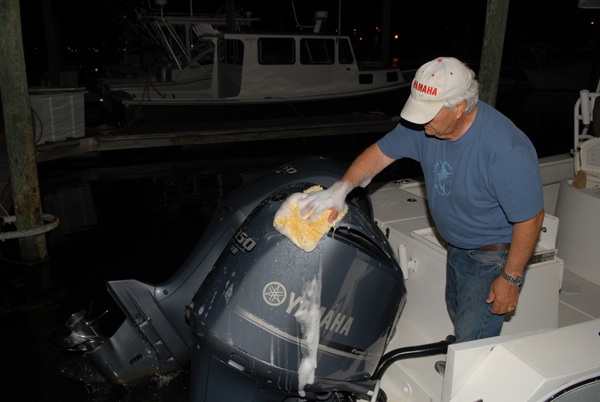.jpg)
Roger owns a 32-foot Regulator® center console powered by twin Yamaha 350 outboards. To look at it resting in the slip at the marina, it appears to have just come off the showroom floor. The sea-foam green hull shines; the white interior and matching white pipework that supports the T-Top gleams in the sun. The isinglass windows of the enclosure are scratch free and crystal clear, and the stainless steel deck hardware sparkles. Even the big Yamaha engines look factory fresh, but looks can be deceiving. Roger purchased the boat new in 2008 and has racked up an impressive amount of hours over the last six years. And they aren’t exactly easy hours, either. While he enjoys taking his grandchildren out for a few hours on the water, Roger is an avid ocean fisherman. He likes pursuing striped bass near shore and tuna considerably further off the beach, even making the occasional foray to offshore canyons found 75-to-100 miles out along the edge of the Continental Shelf. The way he fishes requires a boat that is in top shape mechanically, but it’s obvious he also takes great pride in its appearance.
We caught up with Roger one evening in late spring as he was returning to the marina well after dark. He had been fishing for striped bass with a fishing buddy, and had also battled a 300-pound thresher shark, which was subsequently released. Our discussion centered on what he does to keep his boat in such amazing shape, and it took place while he was going through the ritual he follows after each fishing trip.
“This is not my first boat or my biggest,” said Roger. “I owned a 50-foot, diesel-powered convertible that I kept behind my house for quite a few years. I made a lot of canyon trips in that one. When I sold the house on the water, I decided a smaller outboard-powered boat that I could take out by myself or with a friend would better serve my purposes. I purchased an older 26-foot Regulator with the original Yamaha 225 HPDI engines. The rig had a lot of hours on it, but my mechanic gave the engines a clean bill of health and they ran like a top. The boat looked fair when I purchased it, but it was like new when I sold it and the HPDIs were still going strong.”
Roger is not obsessive about the care and maintenance of his boats, but he does follow a protocol that has served his vessels well over the years.
“I do my best to maintain my boats so they are ready to go fishing whenever I am,” he said. “I always follow the manufacturer’s maintenance schedule on the engines and my own schedule for everything else on the boat. And I always take the time to clean my boat and do all the little things that need to be done after each and every use throughout the season. That is the key to keeping it looking and running like new.”
The 32' is kept in a slip during the fishing season, which for Roger stretches from early April through mid-December, a span of almost nine months. When it comes out at the end of the season, the engines are professionally winterized by a Yamaha-trained mechanic, the fuel on board is treated with the proper additives to prevent it breaking down while the boat is stored, and the freshwater water system and head receive a dose of antifreeze. But that’s not all. Roger also cleans and treats the canvas and isinglass before removing it for storage at home. Then he gives the boat a thorough cleaning with special attention to any stains on the fiberglass and finishes it up with a heavy coat of wax inside and out. All this is done before the boat is shrink wrapped for winter.
In the spring, the boat is commissioned and everything is gone over with a fine-tooth comb. The bottom and running gear below the water line get a fresh overcoat of antifouling paint; the hull and interior are washed down and waxed again. When it’s splashed, the boat looks and runs like new for the start of another fishing season. The key is to keep it that way between uses.
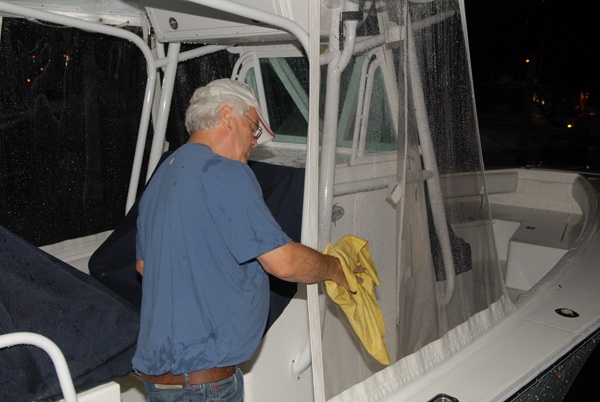.jpg)
Winterization and spring commissioning are important, but just as important for keeping the boat looking and running like new is the ritual performed after each day on the water. Roger walked us through it while he was actually doing it under the lights of the darkened marina.
“Before I put the boat in the slip, I topped off the fuel in the tank,” he said. “When I fuel up, I always add the appropriate amount of Yamaha Ring Free Plus additive. It’s cheap insurance against problems that can occur with ethanol-blended gasoline and it can extend the life of the engine by preventing ring fouling. I used it in the old two-stroke outboards on the 26'. They performed great and were still chugging along when I sold that boat.”
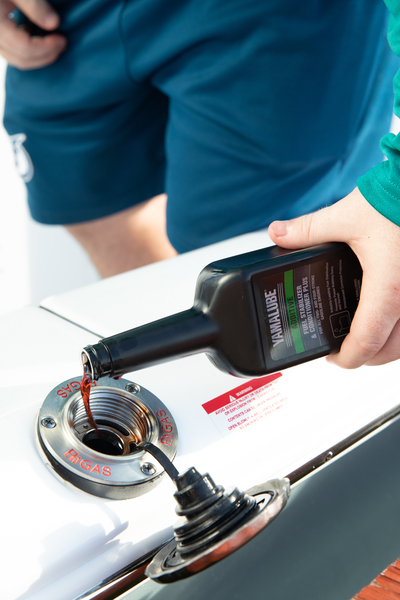
The first thing Roger does at the slip is offload all the gear on the boat, taking time to rinse his rods and reels with fresh water on the dock. He’s maintains his tackle like he maintains his boat, with care. Then he breaks out two hoses, one for cleaning the boat and the other equipped with a quick connect that he uses to flush the engines with fresh water.
“Flushing the engines cleans out any mud or sand the engine might have picked up from the cooling passages and water pump,” he said. “You can see the engine picking up mud off the bottom when docking at low tide. Flushing also cleans out any salt from the system, halting the corrosive effects it can have when left there for days between uses.”
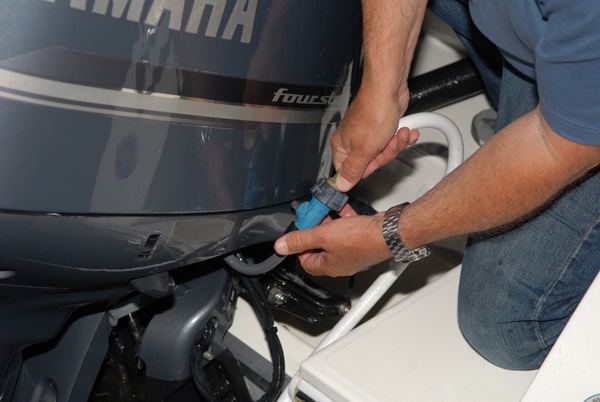.jpg)
While the first engine was flushing, he mixed up a five-gallon bucket full of soapy water to wash down the boat.
“I use a boat soap that contains wax,” Roger said. “It cleans well and leaves a light wax coating on fiberglass surfaces including the nonskid areas, canvas and pipework. You’d be surprised how much pollen and dust can accumulate on surfaces between uses. The wax makes rinsing it off easy. If I haven’t been out on the boat for a week, or more I stop by and spray it down with fresh water.”
Roger took a quick break to switch the hose to the other engine, while explaining some simple things about washing a boat. He uses a soft cloth mitt on most surfaces and a soft or medium deck brush for horizontal surfaces with a nonskid textured finish. If the soap doesn’t remove a dirty spot, a shot of spray stain remover usually does the trick. If the stain is a bit more stubborn he applies a gel fiberglass stain remover and allows it to sit for a few minutes before washing it away.
Roger is particularly careful when washing the isinglass, a clear vinyl used as window material in canvas enclosures. He never uses a brush or rag, only the soft cleaning mitt with soap and water. Then he dries it with a real chamois, not the synthetic type. A chamois is made from porous leather that is extremely soft so it will not scratch the vinyl.
“I never leave the canvas rolled up between uses,” Roger said. “It can actually shrink or take a set from being that way in the sun for periods of time.”
The engine cowlings and pipe work are also washed with the soft mitt, rinsed with fresh water and chamois dried.
With everything clean and both engines flushed, he buttons up the electronics and puts the protective covers on the leaning post and seat on the front of the console. Before turning off the battery switches that hook up the shore power for the onboard battery charger, he makes one last trip to the engines. He raises them as high as they go with the power trim and tilt and then flips down the engine rest so he can completely retract the power trim rams back into the hydraulic cylinders. This keeps them lubricated and protected between uses, instead of exposed to saltwater and the possible effects of any stray electric currents in the water around the boat that can cause galvanic corrosion.
“I take a quick look at the tips of the rams and if they appear dry, I will apply a little waterproof grease before retracting them,” Roger added. “The grease is an added precaution and rarely needs to be addressed, but better safe than sorry.”
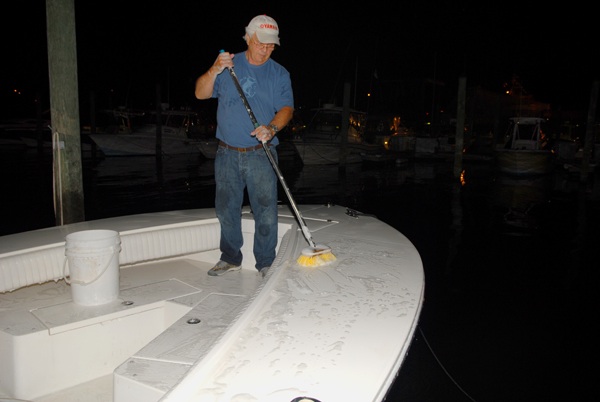.jpg)
Then the boat gets plugged into shore power so the batteries will be maintained at full charge, his cleaning equipment gets rinsed and put in the dock box, and the hoses get wrapped up. The whole process takes about a half hour, less with help from a fishing buddy, but the results are obvious.
As he leaves, Roger usually stops to look at the boat one last time before heading home, knowing it will be there looking great and ready to go fishing at a moment’s notice. Back to Blue Life
.jpg)
Roger owns a 32-foot Regulator® center console powered by twin Yamaha 350 outboards. To look at it resting in the slip at the marina, it appears to have just come off the showroom floor. The sea-foam green hull shines; the white interior and matching white pipework that supports the T-Top gleams in the sun. The isinglass windows of the enclosure are scratch free and crystal clear, and the stainless steel deck hardware sparkles. Even the big Yamaha engines look factory fresh, but looks can be deceiving. Roger purchased the boat new in 2008 and has racked up an impressive amount of hours over the last six years. And they aren’t exactly easy hours, either. While he enjoys taking his grandchildren out for a few hours on the water, Roger is an avid ocean fisherman. He likes pursuing striped bass near shore and tuna considerably further off the beach, even making the occasional foray to offshore canyons found 75-to-100 miles out along the edge of the Continental Shelf. The way he fishes requires a boat that is in top shape mechanically, but it’s obvious he also takes great pride in its appearance.
We caught up with Roger one evening in late spring as he was returning to the marina well after dark. He had been fishing for striped bass with a fishing buddy, and had also battled a 300-pound thresher shark, which was subsequently released. Our discussion centered on what he does to keep his boat in such amazing shape, and it took place while he was going through the ritual he follows after each fishing trip.
“This is not my first boat or my biggest,” said Roger. “I owned a 50-foot, diesel-powered convertible that I kept behind my house for quite a few years. I made a lot of canyon trips in that one. When I sold the house on the water, I decided a smaller outboard-powered boat that I could take out by myself or with a friend would better serve my purposes. I purchased an older 26-foot Regulator with the original Yamaha 225 HPDI engines. The rig had a lot of hours on it, but my mechanic gave the engines a clean bill of health and they ran like a top. The boat looked fair when I purchased it, but it was like new when I sold it and the HPDIs were still going strong.”
Roger is not obsessive about the care and maintenance of his boats, but he does follow a protocol that has served his vessels well over the years.
“I do my best to maintain my boats so they are ready to go fishing whenever I am,” he said. “I always follow the manufacturer’s maintenance schedule on the engines and my own schedule for everything else on the boat. And I always take the time to clean my boat and do all the little things that need to be done after each and every use throughout the season. That is the key to keeping it looking and running like new.”
The 32' is kept in a slip during the fishing season, which for Roger stretches from early April through mid-December, a span of almost nine months. When it comes out at the end of the season, the engines are professionally winterized by a Yamaha-trained mechanic, the fuel on board is treated with the proper additives to prevent it breaking down while the boat is stored, and the freshwater water system and head receive a dose of antifreeze. But that’s not all. Roger also cleans and treats the canvas and isinglass before removing it for storage at home. Then he gives the boat a thorough cleaning with special attention to any stains on the fiberglass and finishes it up with a heavy coat of wax inside and out. All this is done before the boat is shrink wrapped for winter.
In the spring, the boat is commissioned and everything is gone over with a fine-tooth comb. The bottom and running gear below the water line get a fresh overcoat of antifouling paint; the hull and interior are washed down and waxed again. When it’s splashed, the boat looks and runs like new for the start of another fishing season. The key is to keep it that way between uses.
.jpg)
Winterization and spring commissioning are important, but just as important for keeping the boat looking and running like new is the ritual performed after each day on the water. Roger walked us through it while he was actually doing it under the lights of the darkened marina.
“Before I put the boat in the slip, I topped off the fuel in the tank,” he said. “When I fuel up, I always add the appropriate amount of Yamaha Ring Free Plus additive. It’s cheap insurance against problems that can occur with ethanol-blended gasoline and it can extend the life of the engine by preventing ring fouling. I used it in the old two-stroke outboards on the 26'. They performed great and were still chugging along when I sold that boat.”

The first thing Roger does at the slip is offload all the gear on the boat, taking time to rinse his rods and reels with fresh water on the dock. He’s maintains his tackle like he maintains his boat, with care. Then he breaks out two hoses, one for cleaning the boat and the other equipped with a quick connect that he uses to flush the engines with fresh water.
“Flushing the engines cleans out any mud or sand the engine might have picked up from the cooling passages and water pump,” he said. “You can see the engine picking up mud off the bottom when docking at low tide. Flushing also cleans out any salt from the system, halting the corrosive effects it can have when left there for days between uses.”
.jpg)
While the first engine was flushing, he mixed up a five-gallon bucket full of soapy water to wash down the boat.
“I use a boat soap that contains wax,” Roger said. “It cleans well and leaves a light wax coating on fiberglass surfaces including the nonskid areas, canvas and pipework. You’d be surprised how much pollen and dust can accumulate on surfaces between uses. The wax makes rinsing it off easy. If I haven’t been out on the boat for a week, or more I stop by and spray it down with fresh water.”
Roger took a quick break to switch the hose to the other engine, while explaining some simple things about washing a boat. He uses a soft cloth mitt on most surfaces and a soft or medium deck brush for horizontal surfaces with a nonskid textured finish. If the soap doesn’t remove a dirty spot, a shot of spray stain remover usually does the trick. If the stain is a bit more stubborn he applies a gel fiberglass stain remover and allows it to sit for a few minutes before washing it away.
Roger is particularly careful when washing the isinglass, a clear vinyl used as window material in canvas enclosures. He never uses a brush or rag, only the soft cleaning mitt with soap and water. Then he dries it with a real chamois, not the synthetic type. A chamois is made from porous leather that is extremely soft so it will not scratch the vinyl.
“I never leave the canvas rolled up between uses,” Roger said. “It can actually shrink or take a set from being that way in the sun for periods of time.”
The engine cowlings and pipe work are also washed with the soft mitt, rinsed with fresh water and chamois dried.
With everything clean and both engines flushed, he buttons up the electronics and puts the protective covers on the leaning post and seat on the front of the console. Before turning off the battery switches that hook up the shore power for the onboard battery charger, he makes one last trip to the engines. He raises them as high as they go with the power trim and tilt and then flips down the engine rest so he can completely retract the power trim rams back into the hydraulic cylinders. This keeps them lubricated and protected between uses, instead of exposed to saltwater and the possible effects of any stray electric currents in the water around the boat that can cause galvanic corrosion.
“I take a quick look at the tips of the rams and if they appear dry, I will apply a little waterproof grease before retracting them,” Roger added. “The grease is an added precaution and rarely needs to be addressed, but better safe than sorry.”
.jpg)
Then the boat gets plugged into shore power so the batteries will be maintained at full charge, his cleaning equipment gets rinsed and put in the dock box, and the hoses get wrapped up. The whole process takes about a half hour, less with help from a fishing buddy, but the results are obvious.
As he leaves, Roger usually stops to look at the boat one last time before heading home, knowing it will be there looking great and ready to go fishing at a moment’s notice. Back to Blue Life
